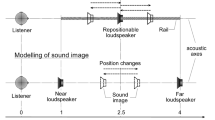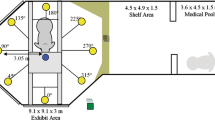Abstract.
To investigate whether the visual system is crucial for adequate calibration of acoustic localization cues, sound-localization performance of early blind humans was compared with that of sighted controls. Because a potential benefit of vision is mainly expected for targets within the two-dimensional (2D) frontal hemifield, localization was tested within this target range, while using sounds of various durations and spectral content. Subjects were instructed to point, in separate experimental sessions, either with their left arm, or with their nose, in the direction of the perceived target position as accurately as possible. The experiments required the use of all available sound-localization cues such as interaural differences in phase and intensity, as well as the complex spectral shape cues provided by the pinnae. In addition, for long-duration stimuli, subjects could have had access to head motion-induced acoustic feedback. Moreover, the two pointing methods allowed us to assess different response strategies for the two groups. In an additional series, subjects were instructed to respond as quickly as possible. The results show that, in general, 2D sound-localization performance of blind subjects was indistinguishable from that of sighted subjects, both for broad-band noise and for pure tones. In the fast head-pointing task, the latency distributions of both groups were equal. These findings suggest that visual feedback is not required to calibrate the available localization cues – including the idiosyncratic and complex spectral shape cues for elevation. Instead, the localization abilities of blind people show that the putative supervising role of vision may be supported, or taken over, by other non-visual feedback systems. The results do not provide support for the hypothesis that blind people can hypercompensate for the loss of vision in the frontal hemifield by developing superior sound-localization abilities. Despite the general correspondence in localization behavior, some specific differences related to pointing strategies as well as to those between blind and sighted subjects were apparent. Most importantly, the reconstructed origin (bias) of arm pointing was located near the shoulder for the blind subjects, whereas it was shifted and located near the cyclopean eye for the sighted subjects. The results indicate that both early blind and sighted humans adequately transform the head-centered acoustic target coordinates into the required reference frame of either motor system, but that the adopted response strategy may be specific to the subject group and pointer method.
Similar content being viewed by others
Author information
Authors and Affiliations
Additional information
Electronic Publication
Rights and permissions
About this article
Cite this article
Zwiers, M., Van Opstal, A. & Cruysberg, J. Two-dimensional sound-localization behavior of early-blind humans. Exp Brain Res 140, 206–222 (2001). https://doi.org/10.1007/s002210100800
Received:
Accepted:
Published:
Issue Date:
DOI: https://doi.org/10.1007/s002210100800




